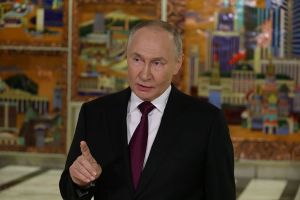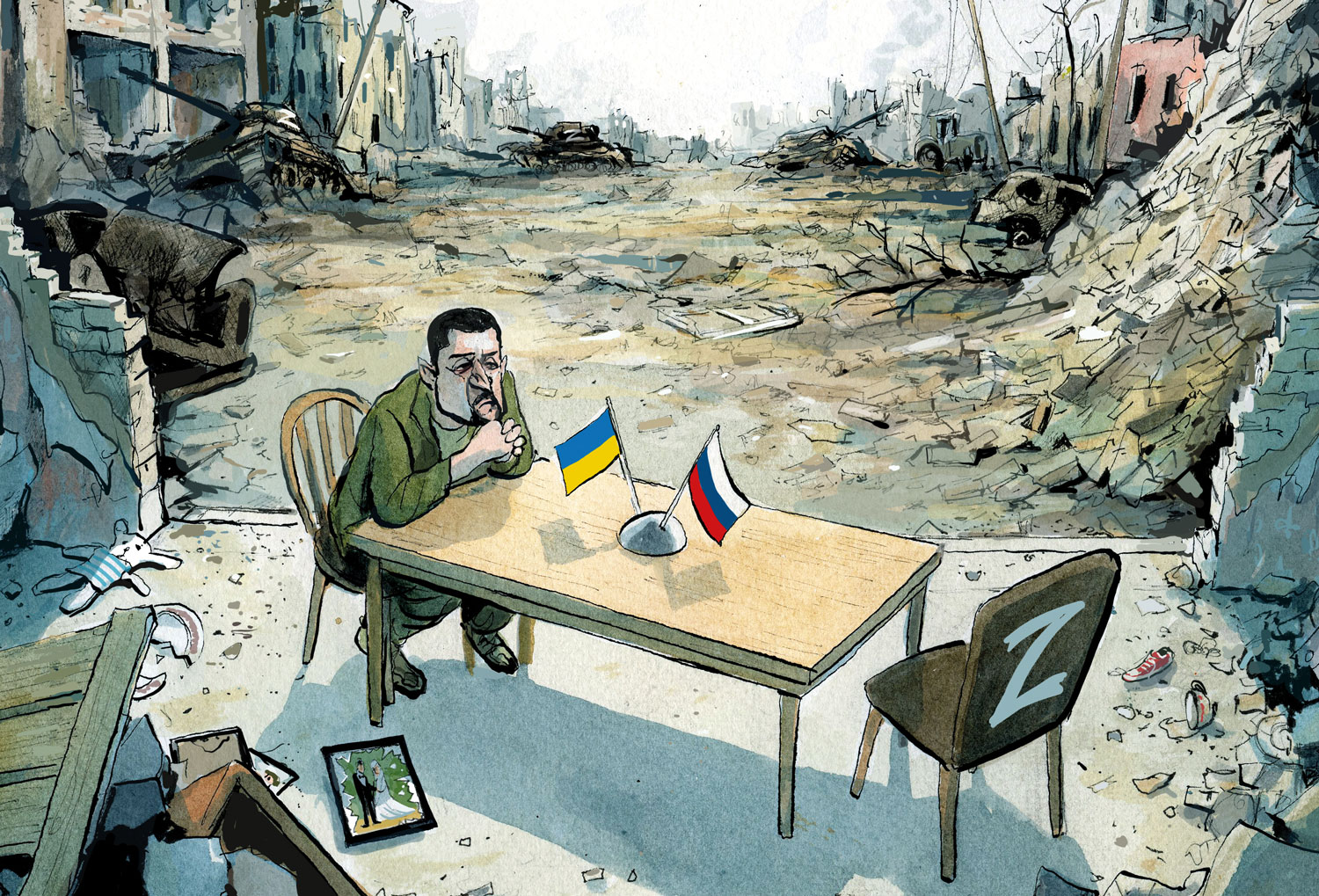Russia is playing a dangerous game in space. Despite its history it’s a declining space power, having abandoned many of its long-term projects due to lack of money and technology. It effectively crippled much of its space activity when it attacked Ukraine, which was the source of many of its high-tech components. This year has seen its lowest launch rate since 1961 – the year Yuri Gagarin became the first person to go into space. Yet significantly, three of Russia’s eight orbital launches this year (the US has launched more than 100) could be potential anti-satellite weapons.
On May 23, Russia launched the Cosmos 2588 satellite from the Plesetsk launch site situated 500 miles north of Moscow. The Cosmos designation is a general term used to obscure the satellites’ purpose. As soon as Cosmos 2588 was detected by the North American Aerospace Defense Command in Colorado, it attracted immediate attention. Its launch was timed, to the second, to shadow a vital US spy satellite.
It was the fourth time in five years that a Russian military satellite was placed in orbital proximity to a US spy satellite, this time USA 338, thought to be a so-called Keyhole 11 optical spy satellite the size of a bus. Providing the sharpest images of the ground from space, it is one of the United States’s most prized assets.
The first time this happened was with the launch of Cosmos 2542 in 2019, which “inspected” USA 245, another Keyhole satellite. But Cosmos 2588 is more than just an inspector. Analysts suspect it houses an anti-satellite weapon equipped with a kinetic missile.
It is part of Russia’s Project Nivelir. None of the four Russian satellites have gotten closer than a few dozen miles to their quarry – but that’s close enough for a good look. When US controllers tweaked their spy satellite’s orbit slightly, Russian controllers matched it.
Some of these satellites display what has been termed “Matryoshka doll” behavior. Cosmos 2542 released a sub-satellite shortly after launch. It shadowed USA 245 and after multiple passes in 2020 fired a projectile after backing off. A warning shot from a sleeper anti-satellite weapon, perhaps.
In June, Russia’s new Angara A5 rocket sent Cosmos 2589 into a complex unique orbit, allowing it to inspect multiple satellites in two key regions of space. Then it also released a sub-satellite and both moved into different orbits. After “sleeping” in space for several years, Cosmos 2542’s sub-satellite recently awoke and lowered its orbit to stalk USA 326, another Keyhole satellite. Then Cosmos 2558 released another unknown object into an orbit that also mirrors USA 326. Russia has also this year launched a trio of formation-flying satellites from the same rocket. One released a sub-satellite while the others carried out complex corkscrew-like maneuvers.
Russia is stalking many western space assets. Its Luch series of signal-gathering satellites are spending time near Eutelsat Konnect, Thor 7, SES-5 and others. These provide communications and internet to Africa, Europe, South America and the Middle East. In March 2024, just before Luch 2 loitered near Astra 4A, its signals were jammed when it was interfering with Ukrainian broadcasts.
Intelligence sources suggest that Russia is planning the ultimate in space destruction – deploying a nuclear anti-satellite weapon. In February 2022, it launched a satellite to test components for it. This is deeply concerning; a nuclear detonation in orbit could take out possibly thousands of satellites in one blow. General Stephen N. Whiting, who serves as commander of the US Space Command, said recently: “The idea that the Russians, the original space superpower… that they are considering doing this is incredibly irresponsible.”
While Russia’s threat might come from desperate actions as it falls behind its rivals, China on the other hand is a rapidly growing space power with an avowed intent to become the world’s premier space nation. It is also performing proximity operations with its satellites in low-Earth orbit. Last year, five different objects were monitored maneuvering in, out and around each other in synchronicity under autonomous control. Vice-chief of US Space Operations General Michael A. Guetlein said: “That’s what we call dogfighting in space.”
In January, China launched its SJ-25 satellite which moved into a synchronized orbit with SJ-21, which in 2022 grappled a defunct Chinese satellite and pulled it into a graveyard orbit – the orbit satellites are sent to when they have finished operational duties. It is thought that SJ-25 will attempt to refuel SJ-21 for another grapple attempt, a belief reinforced when a so-called inspector satellite moved closer to possibly assist and monitor the procedure.
China is a rapidly growing space power with an avowed intent to be the world’s premier space nation
These are significant developments growing the capability to battle in space. There are two ways to knock out an enemy’s satellite: the first is to go into a co-orbit with it and use a missile, laser or electromagnetic pulse to disable it. The problem with this approach is that it requires a dedicated satellite. The other way is more flexible and involves firing a missile from the ground to destroy a satellite. Both China and Russia have already done this to their own satellites.
The militarization of space is a pressing issue that has been growing more urgent since 2015, when China declared space a war-fighting domain. Since then, it has increased its spy satellites by 500 percent. All sides want space superiority. Space is the invisible infrastructure that underpins all our lives. Modern society, and modern warfare, would be impossible without it. Hence, the first thing to do in the build-up to conflict is to attack the space sector. Even in peacetime, assets have been used to cyberattack satellite ground stations or to gain access to or jam data from satellites. Recall that just before Russia invaded Ukraine it disabled Ukraine’s Starlink internet connections – which also affected many parts of Europe.
In July, the US Space Force practiced “orbital warfare” in its largest-ever training exercise. Its chief of space operations, General B. Chance Saltzman, said this was to send a “clear message” that the Space Force is prepared to fight and win. The US knows that since it is the nation that most uses space, it is also the most vulnerable. It is not alone in ramping up its space readiness.
Recently, China reorganized its armed forces, giving space a greater role as it has begun to criticize US military space activities more often. The New Zealand Air Force has just established its first dedicated space unit and recently joined the US-led Operation Olympic Defender – a seven-nation space initiative. NATO is also strengthening its space division.
The Outer Space Treaty (OST) of 1967 is supposed to restrain military activity in space. Everyone is aware of its legal gaps. It bans nuclear weapons and weapons of mass destruction in orbit, but anti-satellite weapons do not fall into that category. At a time when the global geopolitical situation is complicated, each side says it’s only undertaking necessary defensive measures. In March last year, the US and Japan introduced a draft resolution to strengthen the OST, calling on nations not to put nuclear weapons in space. Some 65 member states co-sponsored the resolution, but Russia vetoed it and China abstained. Shortly afterward, China and Russia circulated their own proposals – and the US responded by saying their ideas were fundamentally flawed.
We are seeing the deliberate blurring of the distinction between peaceful and hostile activities in space. Many international behavioral norms are gentlemen’s agreements and, as such, are unsound. While jamming, spoofing, laser dazzling and cyberattacks take place, each side points the finger at the others along with accusations of provocation. Wasn’t that one of the motivations for Russia invading Ukraine?
We might be entering an era when satellites need orbital protectors. France has discussed so-called bodyguard satellites to be stationed near high-value space assets. Last year, the European Commission took up this idea with a study for an “Autonomous SSA Bodyguard Onboard Satellite.” The design of commercial satellites may also have to change; the current crop faced less of a threat when they were made.
Donald Trump’s “Golden Dome,” the US’s proposed protective shield against nuclear attacks, which would be larger and more sophisticated than Israel’s Iron Dome, is something the US space industry has wanted for a long time. It’s a response to criticism that America has neglected the space arena for decades, distracted by the war on terror. Whatever the outcome of this project, it is a huge signal. It resembles President Reagan’s 1983 “Star Wars” program which was, at the time, technically unfeasible. This time, the Golden Dome’s initial building blocks are already in existence. Its first iteration would require software automation, integration of space sensors and AI. Space-based interceptors will be needed. They could be dual use: defense and first-strike.
The US and its allies all have plans for space warfare. Space is becoming more dangerous
The UK is not a major player in this new frontier. It is a valued partner to the US, but some would say not as much as Canada and Australia. Britain is in the lower half of military space spending among the G20 nations, concentrating more on monitoring what’s going on in orbit – or space situational awareness. Major General Paul Tedman, head of UK Space Command, has spent time with US Space Command and recently said the first strike in a conflict with Russia would be in space.
What would be the signs of imminent space warfare? In the build-up to conflict in space, the Starlink system is an obvious target. Earlier this year, it was reported that Chinese scientists had used AI to create attack scenarios on Starlink satellites. Nanjing University – described by Chinese authorities as one of the “seven sons” of China’s national defense – suggested that 99 Chinese satellites hunting in packs, firing lasers and microwaves, could disrupt 1,400 Starlink satellites in just 12 hours.
All this shows how dramatically the space environment has changed in the past decade. Space was seen as a force multiplier for traditional forces; now it is a frontier in its own right. Russia and China are challenging what have been seen as acceptable norms in space. The US and its allies also have plans for space warfare. Space is becoming a more dangerous place. Everyone is watching.
This article was originally published in The Spectator’s September 15, 2025 World edition.


























Leave a Reply